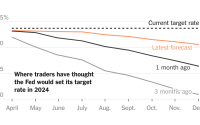CVS Says It Will Change the Way Its Pharmacies Are Paid
CVS Health, the nation’s largest pharmacy chain with more than 9,000 locations, said on Tuesday that it planned to change the way its pharmacies are paid for the medications they dispense, in an apparent attempt to address widespread criticism from health plans and employers about high drug costs.
The new model, which will begin to go into effect next year, involves a complex corner of the opaque world of drug pricing. The idea is to pay pharmacies an amount that more closely reflects how much they spend on a medicine and to provide more information about those payments to health plans and employers, which act as payers.
Prem Shah, who leads CVS’s pharmacy business, said the company’s goal was “to provide a much more transparent model that provides predictability and value for the payers in a way that is more aligned in terms of the way that any other normal market would work.”
CVS said the new model would not translate into immediate savings for consumers. It was unclear whether the new model would result in lower costs for the health plans and employers that foot most of the bill for prescription drugs.
Adam Fein, a drug-distribution consultant who writes a popular industry blog, said CVS’s new model “reflects the latest attempt to fix the system’s wacky economics.”
Under the current system, pharmacies are paid based on a murky formula that leads to substantial variations across individual medicines. For some drugs, the pharmacy turns a handsome profit, but for others, it barely breaks even or loses money. That model can translate into huge bills for health plans and employers for medicines that can be bought for much less from a wholesaler.
CVS’s new model would instead compensate pharmacies based on how much they paid for a drug. The model would also build in a set markup and a fee for pharmacy services.
CVS is best known for its pharmacies, but the most important arm of its business is CVS Caremark, a drug pricing middleman known as a pharmacy benefit manager that works on behalf of health plans and employers. Caremark is the country’s largest pharmacy benefit manager. One of its jobs is to reimburse pharmacies for buying and dispensing a drug, using money collected from health care payer.
A key problem in drug spending “is this intersection between P.B.M.s and pharmacies,” said Antonio Ciaccia, a consultant who works with clients who are scrutinizing their deals with their pharmacy benefit managers.
Mr. Ciaccia said he was skeptical that CVS’s new model would lead to lower costs. “There is nothing in this that explains how this is going to work,” he said.
But others were more optimistic. Dr. Scott Gottlieb, a former commissioner of the Food and Drug Administration, said on CNBC that under CVS’s new model, “the consumer is going to have more insight into what drugs actually cost, and it’s going to also help the pharmacies have more stability in their revenue.”
CVS said the new payment model would not generally apply to so-called specialty drugs, which are expensive medications for complex and serious conditions. It also would not apply to pharmacies run by independent pharmacists, many of whom say that they are being paid by pharmacy benefit managers at levels too low to keep their businesses afloat.
One payer, the large nonprofit insurer Blue Shield of California, recently dropped CVS as its main pharmacy benefit manager and turned to competitors to handle some of its prescription claims. But on Tuesday, it applauded CVS’s announcement: “There is a clear need to remake the pharmacy care system into one that is more transparent, sustainably affordable, and provides quality experience for everyone,” said Sandra Clarke, the chief operating officer of Blue Shield of California.


